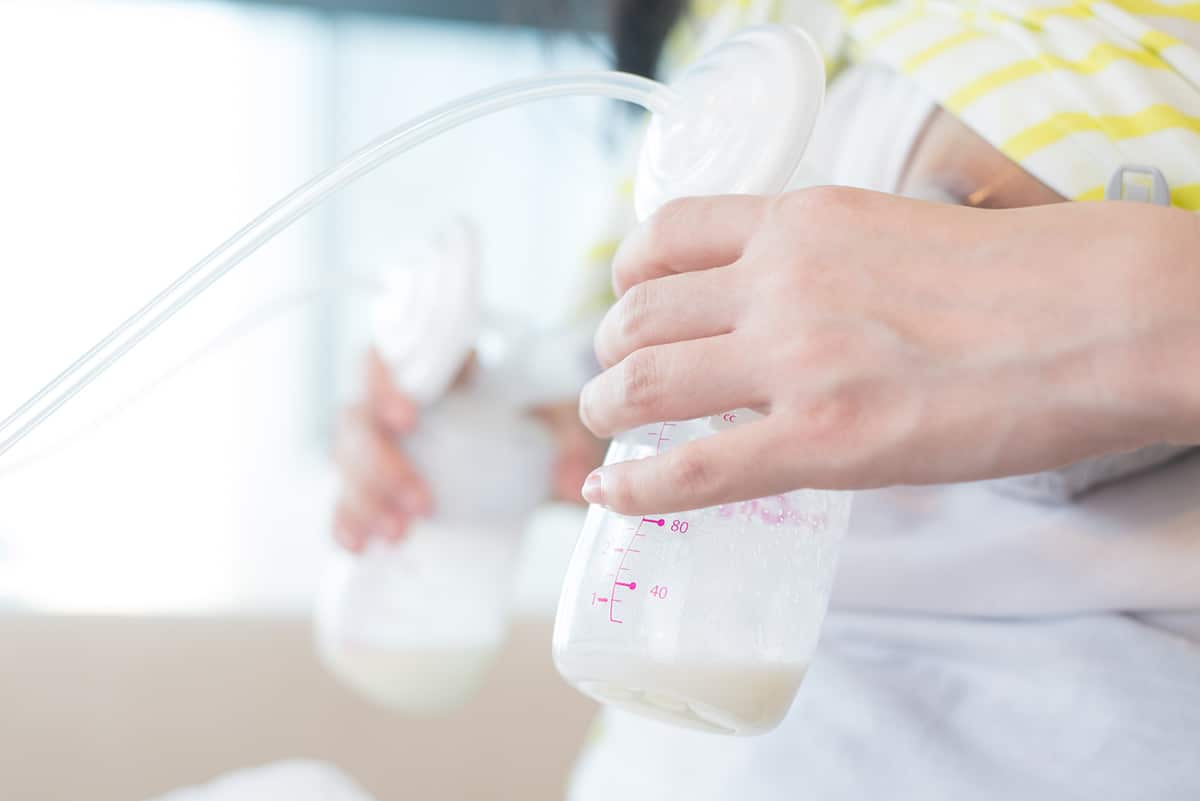Get all of your breast pumping questions answered so you’re never left clueless as a new mom! Learn all of the best tips and tricks to make your breast pumping experience the best it can be!

Breastfeeding is such an incredible experience! Knowing your little one is so helpless and reliant on you for life, nutrients, and protection is heartwarming.
But by now, you can testify of the daily and hourly demands that breastfeeding places on new mothers.
Pumping breast milk seems easy when you read articles, watch videos, and even when you hear of other mothers who do it. But it takes hands-on practice to get comfortable with the process – even power pumping is a thing you can try!
Breastfeeding takes a lot out of new mothers. So turning to the breast pump for help may be the biggest source of relief to you on your breastfeeding journey.
Read on to learn all you need to know about breast pumping milk for your little one.
Breast Pumping Guide for New Moms

Benefits of Breast Pumping
As you know, breastfeeding has many benefits. But let’s take a look at how pumping can make your life as a new mother so much easier!
Here are some reasons why you should be pumping:
- Someone will be able to feed your child when you need to rest, step away, or go back to work
- You can pump on a flexible schedule that works for you
- Pumping allows you to store up milk for the future
You see? Your breastpump is a must-have! There are so many ways breast pumping enhances your breastfeeding experience. And I believe the number one benefit is convenience!
Select Your Pump
So, where to start?! Well, if you haven’t already, begin by choosing a pump.
There are a few things you need to know before selecting a pump.
One being that the FDA does not recommend using a breastpump that was already used by another woman.
As of yet, there is no sure way to properly clean and sanitize a breast pump used by another woman. So it’s best to buy your breast pump brand new (not even gently used).
There are a ton of options out there, mama. But here are three of the most common breast pumps to consider while exploring your options.
Medela

Medela pumps are one of the most common pumps because they work incredibly well. I have yet to meet anyone who wasn’t satisfied with the quality of this pump. It’s the best!
You’ll see that it is on the pricier side, but it’s absolutely worth every penny! This Medela pump is also covered by most insurance plans, so find out if it’s covered for you.
Benefits:
- Electric breast pump
- BPA-free
- Easy to use and transport wherever you need to go
- Includes a tote bag with cooler packs which make it easy to store the milk you’ve pumped
- This double pump set makes it possible to pump both breasts at the same time
Lansinoh
The Lansinoh breast pump is a great fit for you if you don’t plan on being away from your baby for long periods of time (such as when you return to work). Or, if you prefer a manual pump to an electric one.
Benefits:
- Very lightweight, easy to use, and easy to clean
- Less pieces to keep up with than an electric pump
- BPA-free
- Comfort fit flanges
- Ergonomic handle
Philips Avent

There are claims that this pump’s suctioning and strength is not the best, so you’ll have to decide if you want to give it a try.
There were however, a lot of mothers that said they would buy this pump again, and recommend it to others.
Benefits:
- Quiet, easy to us, clean, and transport
- 3 different expression settings (low, medium, and high)
- Soft massage cushion with comfort petals
- BPA-free
When Does Breast Milk Come In?
After you’ve given birth, the first food your baby will eat from your breast is called colostrum. Your body will produce colostrum right after the birth of your baby.
This is known as a mother’s “first milk”. This is a thick yellowish (or orange in some cases) substance that is rich in nutrients and antibodies. Just what your baby needs to fight illness and diseases!
Then, after 2-3 days, your regular breast milk will come in. Make sure you’re eating a nutritious breastfeeding diet so you have plenty of energy to fuel your body so it keep producing quality milk.
How Often Should I Pump?

The more you feed your little darling, the more your milk supply will increase, mama. Generally, newborns need to eat about every 1 ½ -3 hours. Make sure to alternate breasts to empty each one.
Exclusively
In some cases, you may just need a break from bringing your baby to your breast to feed. And that’s totally okay, mama! Cracked (and hurting!) nipples happen.
Or, sometimes the baby just isn’t able to latch on properly, making each breastfeeding session difficult, or altogether unsuccessful.
If you’re breast pumping exclusively, the best thing you can do is make sure you stay on a consistent schedule of pumping 8-10 times within a 24 hours period. Do your best to empty each breast at each pumping session. This may take about 15 minutes or so for both breasts. The timeframe really depends because every mother is different.
If your exclusively breastfeeding, full milk production equates to about 25-35 oz per 24 hour period.
If you’re pumping at work, there are two reasons I suggest you get a double breastpump. One, it stimulates milk production. And two, it’ll cut your pumping time in half.
As the mama, you get to choose the best times of the day that work best for you and your baby’s needs!
Non-exclusively
If you’re still feeding your baby at the breast, you should pump in between feedings. Pump anywhere from 30-60 minutes after you nurse, or 1 hour before your next feeding session.
You can also pump right after your baby feeds at the breast, making sure your baby has eaten enough and is completely finished nursing before you begin pumping.
How to Pump
The actual pumping process will depend on if you’re using a manual pump, or an electronic pump. But you’ll find that these same tips will help you along as you make your way through the first weeks.
You may feel a bit uneasy at first, but try not to rush the process. It’s one of those things that requires you to find your own rhythm and discover what works best for you.
Manual Pump
Step #1 Start by washing your hands (always start by properly sanitizing your hands for baby’s health!). Also make sure all the parts to the pump have been sanitized.
Step #2 Gently massage your breasts in an outward motion in the same way that you’d hand express your milk. Use both hands to squeeze one breast at the same time (outward), and then back to its normal position. You want to stimulate your breast prior to pumping because this helps with letdown.
Step #3 Position one breast nipple inside of the breast flange
Step #4 Begin pumping by using the pump handle. As best you can, try to pump in a way that closest reflects the way that your baby sucks.
Thinking about your baby sucking is proven to help your milk letdown reflex. So keep your little one in mind while you pump! :
Step #5 Move on to pump the other breast. Breast pumping is not a technical job where every mother is expected to have the same experience. The amount of milk you’ll pump from each breast will vary just as much as the duration of your pumping session. It may take you pumping back and forth on each breast a few different times before there’s a flow and you’ve collected all the milk you can for that session.
Step #6 When you finish pumping, wash your hands and sanitize your pumping equipment.
Electronic
Step #1 Wash your hands, and sanitize all pumping equipment.
Step #2 Assemble all of the pumping parts together.
Step #3 Position the breast shield over your breast, with your nipple in the center.
Step #4 Turn on the pump. Adjust the pumping speed and suction controls to reflect that of the way your baby sucks. Then collect as much milk as you can from that breast.
Step #5 Move to your second breast, and repeat. You may need to switch breasts back and forth to continue collecting milk. Sometimes you’ll be pumping one breast while feeling your milk letting down in your other breast. That is an indicator for you to return to the first breast to collect more milk before you end that pumping session.
Step #6 When finished, wash your hands and sanitize all equipment. It’s best to clean your equipment immediately after your pumping session. Review your pump manual for cleaning instructions.
Pumping at Work
Your nerves may be all over the place as you’re preparing to make your way back to work. But you’ve got this, mama! We’re starting to see that more workplace environments have become more accommodating to nursing mothers!
Under the Affordable Care Act Law, employers covered by the FSLA are required to give employees a break to express milk. Knowing you’re legally entitled to a break to pump eliminates stress and gives you the time you need without sacrificing your lunch breaks.
That said, here are the most important things to keep in mind while pumping at work.
- If you have access to a refrigerator, you can eliminate your need to wash the parts (at least until the end of the day!). All you need to do is place equipment in a clean zip lock bag and place it into the freezer or fridge to keep it cold.
- Pump in a clean, comfortable place. I would not recommend pumping in your car or in the bathroom at work.
- Stay on a schedule. However, don’t dismiss the hints your body is giving you. If your breasts are full and becoming engorged, then head for the pump!
For more support, make sure to check out this post where I talk about the Milkology: The Ultimate Back to Work Pumping Class.
Establishing a Schedule

On average, you should be pumping 8-10 times per day. Don’t worry if you’re not able to drop what you’re doing and pump right down to the exact minute.
As long as you’re not skipping entire feedings, your body will stay on the right track with milk production.
Even if you’re super organized, those sleepless nights can keep prevent brain fog from ever lifting.
A breastfeeding tracker will have you doing your happy mamma dance in no time. They’re easy to use, easily transportable, and make it crazy simple for you and your pediatrician to see (at a glance) your baby’s real time feeding schedule.
Relieving Engorgement
Breast engorgement is extremely common for new mothers to experience within the first 3 days of baby’s delivery. This is because your body is transitioning from producing colostrum, to supplying the milk your baby will eat.
Days 3-5 postpartum are usually the worst because the breasts become rock hard with milk and it hurts. Whether you plan to breastfeed, breastpump, formula feed, or do a combination…your body still goes through the same process for those first few days after delivery.
Here are 3 ways you can find relief when you’ve become engorged:
- Pump on schedule
- Clean your clogged milk duct duct
- Hand express milk or use your pump
Storing Milk
Knowing how to store your milk is important so you don’t waste the precious amounts you’ve gathered.
If you’re planning to head back to work and will be spending more time away from baby, it’s best to start pumping in as far ahead in advance as possible. I would give yourself at least 3 months. That gives you time to get used to pumping and store up as much as you can.
You’ll eliminate the stress of not having enough milk, or your milk drying up and there not being enough supply.
Here are some key things to remember when storing milk:
- Milk can be stored in the freezer anywhere from 4-6 months, and in the refrigerator for up to 24 hours.
- Heat the milk in a milk storage bag or bottle by placing the bag or bottle in hot water. You can also place the bottle on a bottle warmer. (DO NOT heat the milk in a microwave or boil the milk directly.
- Do not refreeze breastmilk that has already been thawed
- Store your milk in the back of the freezer and fridge as opposed to on the door
But that’s not it! I go into even more depth on storing breastmilk in this post. Check it out to learn more and get your questions answered on how to store your milk.
Best Time to Pump
Most moms experience the more success when they pump in the mornings as opposed to other times of the day. So try it! Pump and store, mama!
When to Wean

The American Academy of Pediatrics recommends breastfeeding your baby exclusively until your baby is at least 6 months old. Unfortunately, this isn’t always possible- even for the mothers that love it so much they would do it for a year!
Life happens- returning to work, attending college, health issues, and needing another caregiver to step in to care for your child while you’re away.
Overall, this decision really is up to you, mama. Your circumstances will never look absolutely identical to mine, or any other mother’s. Just know this…when you wean has no bearing on how great a mother you are.
You’re amazing! The decision to stop earlier than you’d hoped is not a reflection of your ability to parent well.
Wrapping Up
There it is! Like breastfeeding, breast pumping can take quite a bit out of you. Knowing what to expect as well as learning the best tips when it comes to breast pumping just makes life as a new mom tons easier. Now you can kiss the overwhelm and exhaustion goodbye, mama.
Replace that anxious energy with positive things like singing songs while you hold your precious baby!
It’s your turn now. What tips have you found helpful? Share with me in the comments! Let me know if I missed any important tips and I’ll add them in.
Remember to pin this!




Leave a Reply